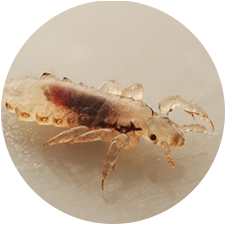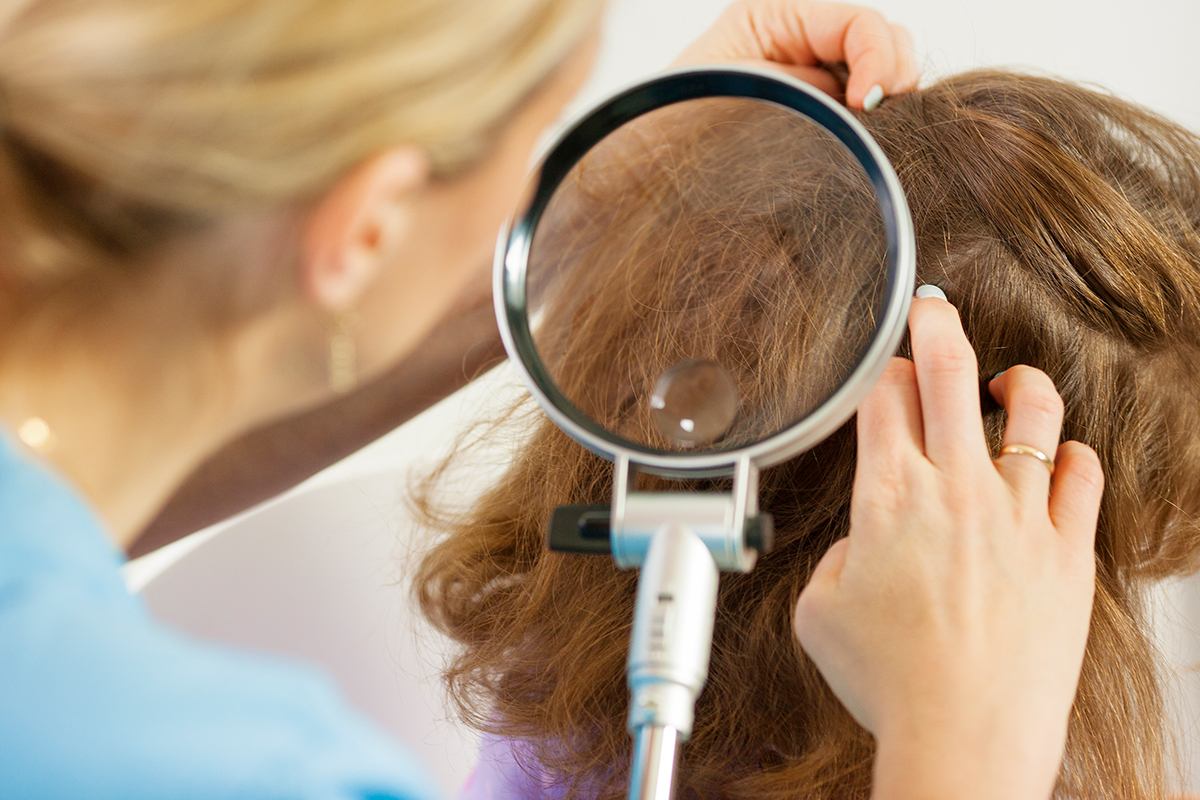What to Look For
-
What Are Lice?
Lice are parasitic insects that feed on blood and can be found on people's heads and bodies, including the pubic area. Lice found on each area of the body are different from each other. The three types of lice that live on humans are:
- Pediculus humanus capitis (head louse),
- Pediculus humanus corporis (body louse, clothes louse), and
- Pthirus pubis ("crab" louse, pubic louse)
Lice infestations (pediculosis and pthiriasis) are spread most commonly by close person-to-person contact or through sharing personal items such as clothing, hats and hairbrushes. Dogs, cats, and other pets do not play a role in the transmission of human lice. Lice move by crawling; they cannot hop or fly.The most common symptom of lice is itching but there are different symptoms, depending on which type of lice you have.
Head lice may not cause any symptoms at first. Itching on the scalp may start weeks or even months after lice have started to spread.
Pubic lice cause severe itching. Their bites may cause small marks that look like bruises on the torso, thighs, or upper arms. If pubic lice get on the eyelashes, the edges of the eyelids may be crusted. You may see lice and their eggs at the base of the eyelashes.
Body lice cause very bad itching, especially at night. Itchy sores appear in the armpits and on the waist, torso, and other areas where the seams of clothes press against the skin. The lice and eggs may be found in the seams of the person's clothing but are typically not seen on the skin.



-
What is Scabies?
Scabies is an itchy skin condition caused by a microscopic mite called Sarcoptes scabei or human itch mite. The mite burrows into the skin and within several weeks, an allergic reaction occurs and severe itching begins.
In most cases, scabies develops after close, prolonged contact with another person. Scabies can easily be spread between sexual partners and household members. Scabies-causing mites can be scratched off the skin and can cause an infestation in another person. Infestation may also occur by sharing clothing, towels, and bedding -- mites can live in bedding for up to 24 hours or more.
-
What Do Lice Look Like? Do I Have Lice?
Head Lice
Head lice have three forms: the egg (also called a nit), the nymph, and the adult.
Egg/Nit: Nits are lice eggs laid by the adult female head louse at the base of the hair shaft nearest the scalp. Nits are firmly attached to the hair shaft and are oval-shaped and very small (about the size of a knot in thread) and hard to see. Nits often appear yellow or white although live nits sometimes appear to be the same color as the hair of the infested person. Nits are often confused with dandruff, scabs, or hair spray droplets. Head lice nits usually take about 8–9 days to hatch. Eggs that are likely to hatch are usually located no more than ¼ inch from the base of the hair shaft. Nits located further than ¼ inch from the base of hair shaft may very well be already hatched, non-viable nits, or empty nits or casings. This is difficult to distinguish with the naked eye.
Nymph: A nymph is an immature louse that hatches from the nit. A nymph looks like an adult head louse, but is smaller. To live, a nymph must feed on blood. Nymphs mature into adults about 9–12 days after hatching from the nit.
Adult: The fully grown and developed adult louse is about the size of a sesame seed, has six legs, and is tan to grayish-white in color. Adult head lice may look darker in persons with dark hair than in persons with light hair. To survive, adult head lice must feed on blood. An adult head louse can live about 30 days on a person's head but will die within one or two days if it falls off a person. Adult female head lice are usually larger than males and can lay about six eggs each day.
Where are head lice most commonly found?
Head lice and head lice nits are found almost exclusively on the scalp, particularly around and behind the ears and near the neckline at the back of the head. Head lice or head lice nits sometimes are found on the eyelashes or eyebrows but this is uncommon. Head lice hold tightly to hair with hook-like claws at the end of each of their six legs. Head lice nits are cemented firmly to the hair shaft and can be difficult to remove even after the nymphs hatch and empty casings remain.
What are the signs and symptoms of head lice infestation?
- Tickling feeling of something moving in the hair.
- Itching, caused by an allergic reaction to the bites of the head louse.
- Irritability and difficulty sleeping; head lice are most active in the dark.
- Sores on the head caused by scratching. These sores can sometimes become infected with bacteria found on the person's skin.
Pubic Lice
What do pubic lice look like?
Pubic lice have three forms: the egg (also called a nit), the nymph, and the adult.
Nit: Nits are lice eggs. They can be hard to see and are found firmly attached to the hair shaft. They are oval and usually yellow to white. Pubic lice nits take about 6–10 days to hatch.
Nymph: The nymph is an immature louse that hatches from the nit (egg). A nymph looks like an adult pubic louse but it is smaller. Pubic lice nymphs take about 2–3 weeks after hatching to mature into adults capable of reproducing. To live, a nymph must feed on blood.
Adult: The adult pubic louse resembles a miniature crab when viewed through a strong magnifying glass. Pubic lice have six legs; their two front legs are very large and look like the pincher claws of a crab. This is how they got the nickname "crabs." Pubic lice are tan to grayish-white in color. Females lay nits and are usually larger than males. To live, lice must feed on blood. If the louse falls off a person, it dies within 1–2 days.
Where are pubic lice found?
Pubic lice usually are found in the genital area on pubic hair; but they may occasionally be found on other coarse body hair, such as hair on the legs, armpits, mustache, beard, eyebrows, or eyelashes. Pubic lice on the eyebrows or eyelashes of children may be a sign of sexual exposure or abuse. Lice found on the head generally are head lice, not pubic lice.
Animals do not get or spread pubic lice.
What are the signs and symptoms of pubic lice?
Signs and symptoms of pubic lice include
- Itching in the genital area
- Visible nits (lice eggs) or crawling lice
Body Lice (from the CDC)
Adult body lice are 2.3–3.6 mm in length. Body lice live and lay eggs on clothing and only move to the skin to feed.
Body lice are known to spread disease.
Body lice infestations (pediculosis) are spread most commonly by close person-to-person contact but are generally limited to persons who live under conditions of crowding and poor hygiene (for example, the homeless, refugees, etc.). Dogs, cats, and other pets do not play a role in the transmission of human lice.
Improved hygiene and access to regular changes of clean clothes is the only treatment needed for body lice infestations.
-
What Does Scabies Look Like? Do I Have Scabies?
Scabies
What are the signs and symptoms of scabies infestation?
The most common signs and symptoms of scabies are intense itching (pruritus), especially at night, and a pimple-like (papular) itchy rash. The itching and rash each may affect much of the body or be limited to common sites such as the wrist, elbow, armpit, webbing between the fingers, nipple, penis, waist, belt-line, and buttocks. The rash also can include tiny blisters (vesicles) and scales. Scratching the rash can cause skin sores; sometimes these sores become infected by bacteria.
Tiny burrows sometimes are seen on the skin; these are caused by the female scabies mite tunneling just beneath the surface of the skin. These burrows appear as tiny raised and crooked (serpiginous) grayish-white or skin-colored lines on the skin surface. Because mites are often few in number (only 10-15 mites per person), these burrows may be difficult to find. They are found most often in the webbing between the fingers, in the skin folds on the wrist, elbow, or knee, and on the penis, breast, or shoulder blades.
The head, face, neck, palms, and soles often are common areas of infection in infants and very young children, but usually not adults and older children.
Persons with crusted scabies may not show the usual signs and symptoms of scabies such as the characteristic rash or itching (pruritus).
-
What Are My Treatment Options?
Head Lice
A head lice treatment lotion that kills the lice containing 1% permethrin or a mousse containing pyrethrins and piperonyl butoxide can be used to treat head lice. These products are available without a prescription at a local drug store or pharmacy. Ask the pharmacist for these products as they are sold behind the counter in Canada. These medications are safe and effective when used as directed.
Pubic Lice
A lice-killing lotion containing 1% permethrin or a mousse containing pyrethrins and piperonyl butoxide can be used to treat pubic lice or "crabs." These products are available without a prescription at a local drug store or pharmacy. Ask the pharmacist for these products as they are sold behind the counter in Canada. These medications are safe and effective when used as directed.
Body Lice
A body lice infestation is treated by improving the personal hygiene of the infested person, including assuring a regular (at least weekly) change of clean clothes. Clothing, bedding, and towels used by the infested person should be laundered using hot water (at least 130°F) and machine dried using the hot cycle.
Sometimes the infested person also is treated with a pediculicide, a medicine that can kill lice; however, a pediculicide generally is not necessary if hygiene is maintained and items are laundered appropriately at least once a week. A pediculicide should be applied exactly as directed on the bottle or by your physician.
If you choose to treat, guidelines for the choice of the pediculicide are the same as for head lice.
Scabies
Scabies is treated using products used to kill scabies mites called scabicides. Treatment options include lotions containing Permethrin. Permethrin is a synthetic pyrethroid similar to naturally occurring pyrethrins which are extracts from the chrysanthemum flower. Permethrin is safe and effective when used as directed. Permethrin kills the scabies mite and eggs. Permethrin is the drug of choice for the treatment of scabies. Two (or more) applications, each about a week apart, may be necessary to eliminate all mites, particularly when treating crusted (Norwegian) scabies.
Simple Tips for Prevention
- Teach Good Habits. Personal belongings such as brushes, hats, and towels can pass lice. So don't share.
- Be Aware of Shared Spaces. Keep personal items (hats, coats, etc) out of common areas.
- Avoid Outbreaks. If you know of an outbreak, avoid locations where head-to-head contact would occur like sporting activities.
Where to Buy
Click to see which stores carry our lice treatment products.

Lice Can’t Jump: 10 Myths about Head Lice Debunked
Pets transmit lice. False!

